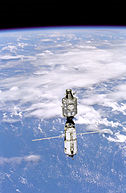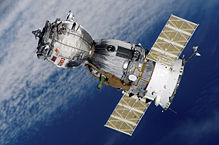The International Space Station is an artificial station that is mounted in space and orbiting the Earth. It is a research, educational and commercial space station as well as a stepping-stone to future space exploration. Here are some facts about this amazing st
 The International Space Station picture with the Earth’s Rugged Terrain in the Backdrop Image Source
The International Space Station picture with the Earth’s Rugged Terrain in the Backdrop Image Source
What Is The International Space Station?
The International Space Station (ISS) is a habitable artificial satellite that is in low Earth orbit. It is the largest man-made object ever mounted in space and the ninth space station with human beings working and living on-board. It is also the most sophisticated international scientific and engineering space project ever built.
Development of the International Space Station
The International Space station is truly an international mission. Its existence is thanks to the collaborative effort of several countries that are the US, Canada, Japan, Brazil, Russia and the 11 member nations of the European Space Agency (ESA).
This space station was not assembled on Earth and launched into space as a complete structure. Rather, it was built in space piece by piece until all the modules were constructed in 2011.
The components were launched by American Space Shuttles, Russian Proton and Soyuz rockets. Russia’s Zarya module was the first component to be launched in 1998.
Zarya Deploying in 1998 Image Source
The first expedition crew began working and living in the station in 2000. It is expected to continue in operation for at least another decade through at least the year 2020.
The International Space Station Purpose
The International Space Station was designed to be a laboratory, observatory and factory facility in space. It has a state of the art laboratory for testing new technologies and an observation platform for conducting astronomical, geological and environmental research.
It was also intended to act as a preparation, transportation, maintenance and staging center for future space exploration including future possible missions to the Moon, Mars and asteroids.
Scientists in the station are investigating how microgravity affects health in the long term. This information will help astronauts prepare for a mission to Mars in the near future.
Astronomers are also conducting experiments at the exterior of the station to study the space environment and determine how long-term exposure to conditions in space affects materials. This research will help in the design of spacecrafts intended to explore space.
The crew members also conduct experiments in biology, physics, Earth and space science, meteorology, astronomy, physical sciences and other areas.
In 2010, the station was also assigned commercial, diplomatic and educational purposes.
The International Space Station Facility
The International Space Station is a modular structure made up of pressurized modules, solar arrays, external trusses and other components.
The modules and nodes provide living space complete with all facilities for the on board crew. The laboratories are also located here. The exterior trusses offer structural support and the solar panels are the source of power.
It is like the size of a football field and weighs 390, 908kg or 861.8704 pounds. It is almost four times as large as Mir, the Russian space station and around five times as large as the US Skylab.
The International Space Station Crew
Human beings have lived and worked on-board the International Space Station continuously since Nov 2000. Each expedition crew normally stays for 4-6 months inside the station before another crew comes in. The space based crew is assisted in running the station by Earth based mission control centers and a payload control center.
Russian Soyuz vehicles are the means of transport for the crew leaving the station and coming back to Earth as well as new crew members coming to occupy the station.
Soyuz Spacecraft Image Source
In 2009, the space station was finally able to accommodate a six-person crew after all the modules, laboratories and facilities were installed in the station.
The International Space Station in Orbit
The International Space Station orbits the Earth at a 51.6º angle of inclination. It orbits every 90 minutes at a very fast speed of approximately 17, 500 miles per hour (28,000kph). In one day, it completes 15.7 orbits covering a very large distance that is equivalent to travelling from the Earth to the Moon and back.
It is located 248 miles (400km) above the Earth. This position allows easy accessibility for the crew and the supplies and makes it possible to cover 85% of Earth.
International Space Station Sighting from Earth
The International Space Station is so large that it is visible from earth with the naked eye. You can see it in the night sky without a telescope provided you know when and where to look.
This space station is almost as bright as the brilliant planet Venus and appears as a bright light moving across the night sky. It also looks like an airplane.


